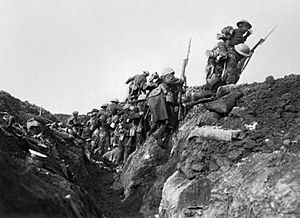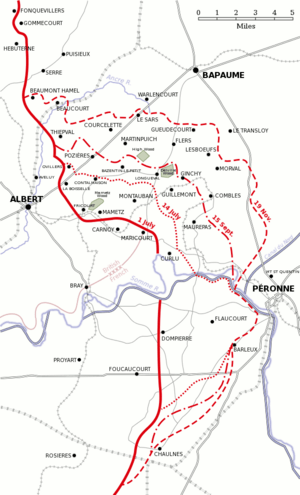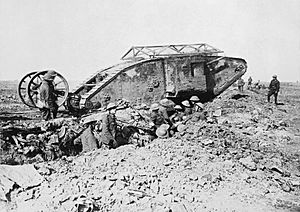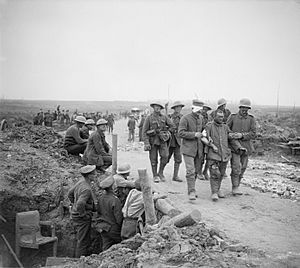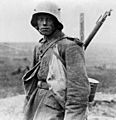Battle of the Somme facts for kids
Quick facts for kids Somme Offensive |
|||||||
|---|---|---|---|---|---|---|---|
| Part of the Western Front of the First World War | |||||||
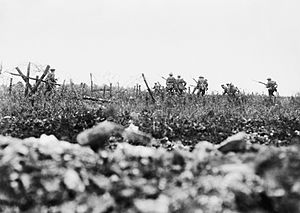 British soldiers attacking |
|||||||
|
|||||||
| Belligerents | |||||||
| Commanders and leaders | |||||||
| Strength | |||||||
| 13 British and 11 French divisions (planned) 51 British and 48 French divisions (actual) |
10½ divisions (planned) 50 divisions (actual) |
||||||
| Casualties and losses | |||||||
| 623,907 casualties 782 aircraft lost |
465,000 men | ||||||
The Battle of the Somme was a huge fight during World War I. It started on July 1, 1916, and ended on November 18, 1916. The battle got its name from the Somme River in France, where it took place.
On the very first day, the British Army suffered a lot. About 57,470 soldiers were hurt or killed, with 19,240 deaths. The French Army had fewer losses, around 1,590. The German Army lost about 10,000 to 12,000 men. The Allies (Britain and France) had planned to attack together. However, the French were busy fighting in the Battle of Verdun. This meant the British did most of the attacking at the Somme.
The Battle of the Somme was very costly for the British. They gained little land for so many lives lost. This has caused much sadness and debate in Britain. For the Germans and French, the first day of the Somme was just one small part of the huge losses they faced earlier in the war and at Verdun.
Overall, more than 1.5 million people were killed, wounded, or went missing during the Battle of the Somme. It was one of the worst battles of World War I, especially for Britain.
Before the attack, the British fired many shells at the German trenches for five days. They hoped to destroy the German defenses. But when the British soldiers were ordered to advance on July 1 at 7:30 am, they faced a surprise. The German trenches were very deep. German soldiers had moved their machine guns to safety during the shelling. They brought them back up quickly when the British attacked.
Many books have been written about why this plan failed. It is clear that the heavy shelling did not work as planned. German machine-gunners survived and were ready. They were supported by their own artillery. This caused the British attack to fail, leading to many casualties. Strong defensive weapons made it very hard to attack. A soldier with a bayonet was not effective against machine guns. Large groups of infantry were also useless.
Contents
Weapons Used in the Somme Battle
Poison Gas
The Germans were the first to use poison gas as a weapon. They used chlorine gas. However, it had a strong smell and was green, so enemies could easily see it. It also sometimes blew back onto the German soldiers. To protect themselves, soldiers started wearing damp material over their mouths and noses. British soldiers were given cotton pads and respirators (gas masks).
Rifles (Guns)
Rifles were common weapons for soldiers in the trenches. The main type was the bolt-action rifle. This rifle could fire 15 rounds per minute. It could also kill a person from 1.4 kilometers away. A Scottish man named James Paris Lee invented this rifle in America.
The bolt-action rifle had a metal box for cartridges. A spring pushed the cartridges up. When the bolt opened, it pushed the top cartridge into the chamber. After firing, opening the bolt would throw out the empty cartridge case. Closing the bolt would load a new round. These rifles could hold 3, 5, or 29 cartridges.
Machine Guns
Machine guns were big and needed at least four men to operate them. They had to be placed on a flat surface. Each machine gun had the firing power of many rifles. Larger field guns needed up to 12 men. They fired shells that exploded on impact.
Machine guns were a huge advantage for the Germans. They used them very effectively. British forces often walked across No Man’s Land directly into heavy gunfire. The British did not have many machine guns. This made their task much harder. The Germans had the upper hand because their positions were often higher than the British.
Tanks
The first tank was called 'Little Willie'. It had a crew of three men. Its top speed was only three mph. It also struggled to cross the wide trenches. The first tank battle was Flers-Courcelette. It began on September 15, 1916. Only 36 out of 49 planned tanks arrived for the battle.
This was the first time tanks were used in World War I. However, they were lightly armed. Their mechanics often broke down. So, they did not have a huge impact at first. Still, few tank crew members were hurt.
Mines
Land mines were used to surprise and damage the enemy. These explosives have been used since gunpowder was invented. They were used to defend fortresses in the 18th and 19th century. For example, the British attack on Badajoz saw many soldiers hurt by mines. These early mines were set off by a defender lighting a fast-burning fuse.
The British used 11 mines on the first morning of the Battle of the Somme. They wanted to shock and damage the German front line. The large holes left by these explosions were later used by the Germans for their machine guns. Soldiers who set these land mines were called sappers.
Life in the Trenches
Life in the trenches was very hard. There was a lot of disease. The toilets were often just buckets or holes. This caused diseases like dysentery to spread quickly. Dysentery causes stomach pains, diarrhea, and sometimes sickness. It can also lead to dehydration, which can be deadly.
The water supply in the trenches was not good. Soldiers added chloride of lime to clean dirty water from shell holes. But the soldiers did not like the taste. It tasted a bit like swimming pool water!
Soldiers in the trenches also suffered from lice. One soldier said they were "pale fawn in color." They left red bite marks all over the body. Lice caused a lot of itching. They also carried a disease called pyrrexhia or trench fever. The first symptoms were shooting pains in the legs, followed by a very high fever. This disease did not kill the soldiers, but it made them too sick to fight.
Trench foot was another common problem. It was an infection caused by standing in wet conditions for a long time. Soldiers could not dry their shoes and socks. Your feet would first go numb, then turn red or blue. If it got very bad, you could get gangrene, which might mean your foot had to be amputated. Brigadier-General Frank Percy Crozier said that fighting trench foot was "an uphill game." The only way to prevent it was to dry your feet and change your socks many times a day.
Many men injured in the trenches had parts of their bodies removed. This happened from being wounded or from limbs being blown off by mines or shells. There was also a big rat problem. One soldier, Harry Patch, even said they were as big as cats.
The area between the two sides was called No Man’s Land. It was very dangerous. It had lots of barbed wire and shell-holes. It was usually a sea of mud. Soldiers who went "over the top" (left their trenches to attack) were easy targets for enemy machine gunners. In the battle, the Allies lost about 600,000 men. The Germans lost just as many.
The Prince of Wales
The Prince of Wales (who later became Edward VIII) served on the Somme as a Staff Officer. He was sad that he could not be directly involved in the fighting. However, his time there helped him understand ordinary soldiers. He earned their respect. This experience influenced his life as Prince of Wales and later as king.
Today
Today, the area where the Battle of the Somme took place has many cemeteries, war memorials, and museums. People can visit these places to remember those who fought. Some farmers still find pieces of barbed wire from the battle. This is sometimes called "iron harvesting."
Interesting Facts About the Battle of the Somme
- The Battle of the Somme showed how futile (pointless) trench warfare could be. Neither side gained much, but many people were hurt or killed.
- It was one of the worst battles in World War I. More than three million men fought. One million men were wounded or killed, making it one of the deadliest battles in history.
- On the first day of the battle, 19,240 British soldiers died.
- The battle helped the British Army get better at fighting.
- Artillery (large guns) was the most destructive weapon on the Western Front.
- The battle lasted for five months. It finally stopped in November when it started snowing.
Images for kids
-
Men of the 10th (Service) Battalion, East Yorkshire Regiment of the 31st Division marching to the front line, June 28, 1916.
See also
 In Spanish: Batalla del Somme para niños
In Spanish: Batalla del Somme para niños


